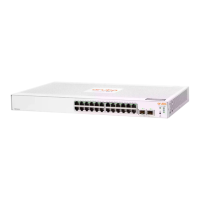Application server commands
Application servers (as described in OOBM and server applications in OOBM concepts on page 732) have
added a listen keyword with oobm|data|both options to specify which interfaces are active.
Default value is both for all servers.
Syntax
telnet-server [listen {oobm | data | both}]
Syntax
ip ssh [listen {oobm | data | both}]
Syntax
snmp-server [listen {oobm | data | both}]
Syntax
tftp server [listen {oobm | data | both}]
Syntax
web-management [listen {oobm | data | both}]
In all cases, show running-config displays the server configurations.
Use the no form of the command to prevent the server from running on either interface.
Examples
Telnet: no telnet-server
SSH: no ip ssh …
SNMP: no snmp-server …
TFTP: no tftp server
HTTP: no web-management …
The show servers command shows the listen mode of the servers:
Switch# show servers
Server listen mode
Server Listen mode
-----------------------------
Telnet | both
Ssh | both
Tftp | both
Web-management | both
Snmp | both
Application client commands
CLI commands for client applications have added the oobm keyword to allow you to specify that the outgoing
request be issued from the OOBM interface. If you do not specify the oobm keyword, the request will be issued
from the appropriate in-band data interface. Command syntax is:
Chapter 22 Network Out-of-Band Management (OOBM) 743

